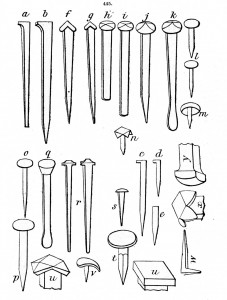We may receive a commission when you use our affiliate links. However, this does not impact our recommendations.
Whenever I teach at a woodworking school, I’m always fascinated by what happens when I open my tackle box full of cut nails. Usually, the students react as if I’d opened a case of ticked-off scorpions.
At The Center for Furniture Craftsmanship, one of the students asked: “Are those allowed here?”
That was on Monday. By Friday, the 11 students were stuffing the extra nails into their pockets and banging merrily away on their projects – driving the 4d clinch rosehead nails and cut headless brads into their small dovetailed chests.
Many of them now see cut nails like I see nails: as an important piece of hardware on a traditional project. Cut nails hold like crazy and look quite nice in traditional work. And we are not the first people to think this.
In 1810, nails were 0.4 percent of our nation’s gross national product, according to a July 2011 report on the prices of nails and screws since 1700 that was prepared by Daniel Sichel of the Federal Reserve Board.
“In today’s terms, this share is similar to that of household purchases of personal computers and peripherals or of airfares,” Sichel writes.
All the cut nails I buy come from Tremont Nail, which manufactures them on antique equipment at Mansfield, Mass. I had hoped to get to Tremont for a tour during this trip to New England, but my dance card was full. Perhaps next time. As far as I know, Tremont is the last maker of these nails. If you see cut nails for sale in a catalog (that aren’t masonry nails), they probably came from Tremont originally.
Today I closed up my box of nails as one of the school’s assistants was picking through the wrought nails with an appreciative eye.
— Christopher Schwarz
P.S. The music in the video is by Rose’s Pawn Shop.
Here are some supplies and tools we find essential in our everyday work around the shop. We may receive a commission from sales referred by our links; however, we have carefully selected these products for their usefulness and quality.










A history of nail making :blacksmith, cut nails to wire
http://www.nfb.ca/ film/ nails/
National film board of Canada short.
I was walking the beach one morning in Praia the capital of Cape Verde, an archipelago nation west of Senegal, and came on a boatbuilder who built the fishing boats they use in those waters. The hulls were wood (madeira he called it but I’m not sure if that just means “wood”) and he joined them with galvanized cut nails. Later on he caulked the joints with a caulking mallet and a rope like caulk. Fascinating stuff!
Howard
Then there are these guys,
http://www.glasgowsteelnail.com
I have heard about these types of nails before. However, I never really heard a good explanation of why & when to use them . Besides that they look good.
Thanks
Tremont has a nice sample sheet you can get to see what they offer:
http://www.tremontnail.com/sampleset.htm
(I have no association with Tremont, I just thought it was cool).
-Chris C.
Where did the attached diagram of the nails come from? Did the source include descriptions of the various types and their use? I could see a great article here if there is enough known about them.
I scored a whole box of antique cut nails from a basement in historic Leadville, CO. There must be around 5,000. All appear to be of the A-C categories judging from the diagram above.
They are amazingly straight and rust-free for being approx. 130 years old. Damn, they look good.
I’m a total woodworking noob (just recently progressed beyond the popwood’s ICDT projects) – is there any reason I shouldn’t use these antique nails in projects? They’ll hold as well as those Tremont nails, right?
Off the subject, but does anyone have any information on The Dikemand MFG Co? I have an old tool that I just cannot identify or find any information on . Only thing I can find on The Dikeman is a scraper, but this is a brace bit with external workings as well. I can send a picture, because it will be needed:) Thanks for any help you can provide.
Actually, it would be more accurate to compare saws to computers. Not to downplay screws, but computers are a significant change for the 20th Century and moving forward.
The reason I mention saws is that Henry Disston is much more similar to Bill Gates, and each would be classed by themselves as far as being able to approach it as a business. Such a fascinating story of the Disston empire, even how his son was the largest single landowner in the US of A. People would pay a month’s salary to buy a saw in the old days…and when you think of how valuable a saw was to someone, you could build a house with a saw, certainly with dimensional timber as it arrived in volumes.
Anyway, just sayin’…didn’t mean to poo-poo on your waxed-poetic…lol
Woodworking Magazine Issue 5 has a long article on cut nails:
http://www.shopwoodworking.com/digital-issue-woodworking-magazine-issue-5
I’ve also written quite a lot about them in “The Joiner and Cabinet Maker.”
How about a good treatise on cut nails? Or does one already exist you can recommend?